Before I get to what has been happening in the last seven days, I’ll just highlight again what is coming up during half-term week beginning with this Saturday – two exciting days in Dover with Keith Parfitt’s joint Centre and FCAT talk on Wednesday 31 May.
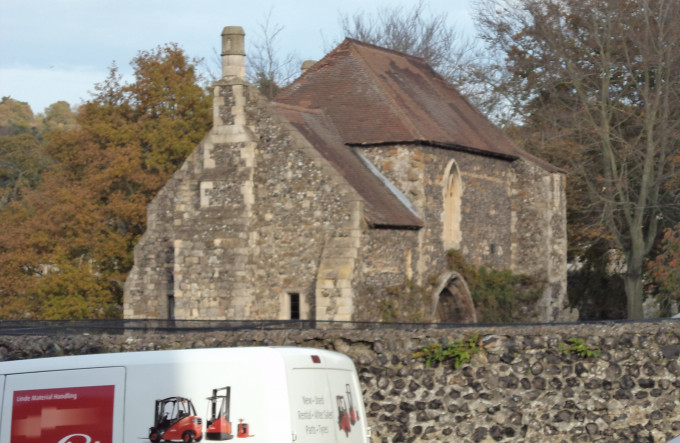
The first of these Dover events is the ‘Dover Family-friendly Pilgrim Trail’ on Saturday 27 May between 10am and 4pm. By following the trail (in whatever order you want, sites are marked on a colourful map), you will be able to visit 8 historic buildings, and the Centre will be involved at two of these. Firstly, Kieron Hoyle will have family-friendly activities at St Edmund’s chapel, while Drs Diane Heath and Pip Gregory, as part of Diane’s NLHF-funded ‘Medieval Animals Network’ project, will be at Dover College (the dissolved Dover Priory) for more creative activities. Do go and visit them if you are doing the trail (or even if you are not), they will be delighted to see you, and for more information, please see the Maison Dieu website: https://www.maisondieudover.org.uk/events
As I said, Wednesday 31 May will bring Keith’s lecture at Canterbury Christ Church University in Laud (building) Lg16 at 7pm when he will speak on ‘Fifty years fossicking in east Kent: a light-hearted review of my archaeological journey’, which promises to be a fascinating and highly enjoyable evening. The lecture is open to the public, but as a way of helping Canterbury Archaeological Trust donations are greatly appreciated.
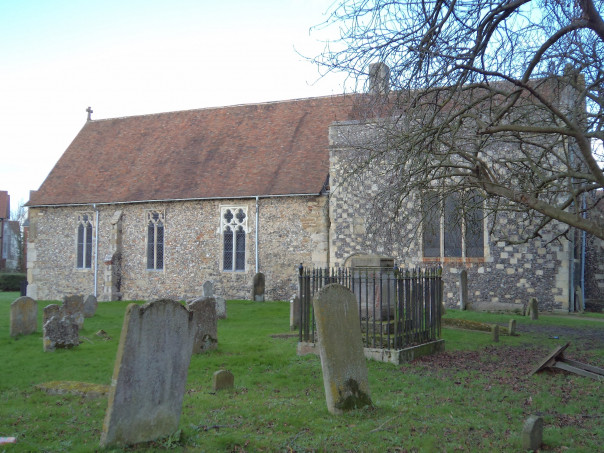
Then turning to the following Saturday 3 June, Dover Museum and the Maison Dieu project will be hosting Kent Archaeological Society’s Kent History Showcase, which is building on the success of the two successful such events last year. This year those showcasing their organisation will be around Dover Museum and in the Market Square at the front and the Centre will be there too, as will Diane’s ‘Medieval Animals Network’, and she is also among the speakers giving short talks under the theme ‘Journeys’.
If that’s all events in the near future, events past begin with my talk to those gathered in St Mildred’s church last Friday. Fortunately, there was a very good number in the audience, which was excellent because, as Tessa said, the Friends need money to tackle the squirrel issue that is now plaguing the church – rodents with furry tails are no laughing matter!! However, we did discover why this came about, but more on that anon.
To bring together Tessa and her church, this talk focused on different aspects of dramatic performance as it might have been experienced by parishioners at St Mildred’s in early Tudor times. Consequently, after a brief overview of plays, pageants and processions nationally, we explored liturgical drama at St Mildred’s, bearing in mind there are no surviving churchwardens’ accounts, and the wills are ‘good’ but not for this topic. Nevertheless, we looked at the great processions, and I had decided to focus on Palm Sunday and the processions in Rogation Week. Two things I think people will remember is the necessity of processing around the church on Palm Sunday clockwise (similarly around the parish at Rogation) – hence the squirrel problem!! And, from Salisbury, that Rogation processions included a dragon with erect tail (Monday and Tuesday), and drooping tail (Wednesday).
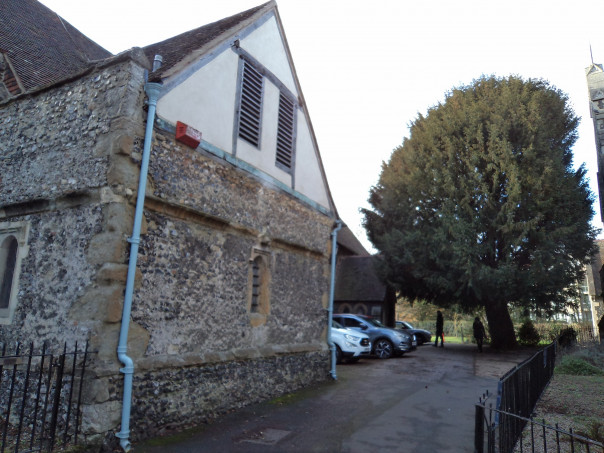
Moving on, we examined other parish processions, including those associated with life-cycle events; then might there have been plays performed at St Mildred’s – perhaps, records from Kent point to an active tradition of parish/town plays, which took us to think about plays more broadly in Canterbury. Having gone through the evidence for venues, timing, performers, subjects and audience, I took the audience back to Canterbury civic processions – mayor-making, those associated with specific saints – St George and St Laurence, meeting royalty, meeting the royal justices, beating the bounds and on Corpus Christi Day.
Now Corpus Christi offered a means to investigate high summer drama in Canterbury because as well as the procession there was a Passion Play performed by the city’s craft guilds, or at least there had been because the civic authorities were upset that it had lapsed in the late 1520s. The mayor and his brethren were much happier about ‘their’ procession with its accompanying pageants on the eve (6 July) of St Thomas’ Translation. This I went through in more detail, especially the St Thomas pageant, which might be seen as a playlet, thereby bring together in one entity plays, pageants and processions, which the audience seemingly enjoyed from the number of questions and discussions afterwards when we enjoyed the refreshments provided by the Friends – thanks Tessa.
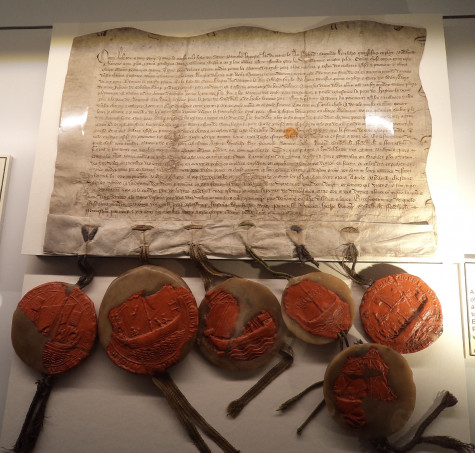
Now to the 2-site conference on Monday 22nd and Tuesday 23rd May entitled ‘Constables, Charters and Kent: a first look at new material in Kent Archives’. We began at the Kent History and Library Centre in Maidstone where we were welcomed by Sarah Stanley and her team with refreshments before the first session on an exploration of the manuscript and its provenance, which has been called the Dover Castle Custumal among other names. The two speakers were Dr Mark Ballard from the Kent Archives Service and Dr James Lloyd, archivist at the College of Arms, who provided an absorbing exploration of the manuscript’s contents – the various texts, and especially the interventions of Sir Edward Dering in the early 17th century. Furthermore, in what reminded me of Arjun Appadurai’s, The Social Life of Things: Commodities in Cultural Perspective, Mark, and especially James, examined in fascinating detail how and why Dering had been able to preserve and enhance, as he would have seen it, this manuscript as well as the longevity of the Dering family as members of the nobility by pushing their ancestry back into the ‘illustrious’ past.
After this great session, as well as more refreshments, we had an opportunity to see the documents the Archives’ staff had put out on display in the seminar room, including custumals from Sandwich and Tenterden. The second session comprised Professor Nicholas Vincent from UEA and me, Nicholas providing an excellent assessment concerning the importance of Dover Castle from its first appearance under Edward the Confessor through to the later Middle Ages by way of Henry II and the Cinque Ports, the First and Second Barons’ Wars of the 13th century, the French attacks of the 1290s and much more. Additionally, he offered some new and interesting ideas about how and why ships were depicted on the Dover seal at different times before moving to discuss Dering’s even greater acquisitive activities regarding the muniments at Canterbury than at Dover.
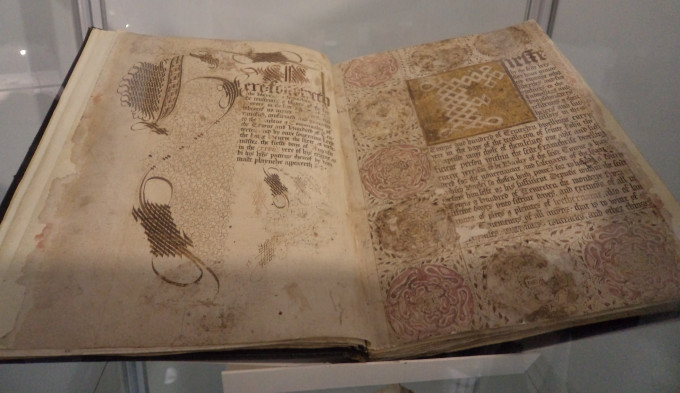
As well as being absorbing, this was extremely handy because I wanted to explore custumal writing in the later Middle Ages among the Cinque Ports in terms of their individual and collective responses to the Constable/Lord Warden as the representative of royal power/officialdom. Obviously, my presentation drew heavily on Dr Justin Croft’s brilliant doctoral thesis of the making of these Cinque Port custumals and it was even better because this was all recorded and will be available shortly on the Kent Archive Service’s website. By so doing, Justin’s work will, I hope, become better known because it should be! From the perspective of the conference, it is the timing of the production and/or re-production of these custumals that I wanted to discuss, and while on the face of it Dover appears to be out on a limb (first known custumal from the early 16th century), I think this is more a matter of losses from the Dover civic archive and that there was an earlier custumal, not least because the mayor had purchased a copy of Magna Carta in the early years of Henry VII’s reign, a time when shared knowledge among the Ports about the conservation of their customs and franchises was seen as important in response to especially active scrutiny by the Tudor monarch.
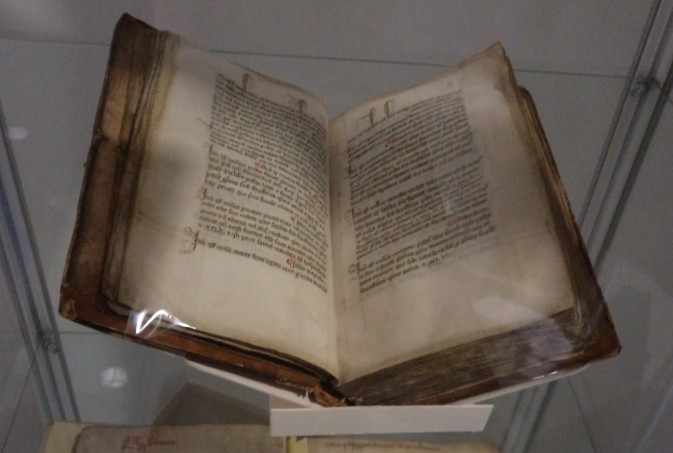
From the buzz around the room, you could tell people had enjoyed the sessions, which set things up nicely for the second day when we gathered in Special Collections in the University of Kent’s library at Canterbury. Having been welcomed by Dr David Rundle and Karen Brayshaw, who heads Special Collections, the speakers for the first session on different aspect of the life and career of Sir Edward Dering were Professor Kenneth Fincham from the University of Kent and Kaye Sowden, a doctoral postgraduate at Canterbury Christ Church, although regular blog readers will know this already. This worked extremely well because Ken discussed Dering’s early career at court, including his desire to gain the patronage of Buckingham, and then his activities as Lieutenant at Dover Castle and his parliamentary career as a knight of the shire. In particular, Ken focused on Dering’s attitude regarding Archbishop Laud and what others saw as his changeable religious views, albeit Dering saw himself as justified in his stance and sought to promote this through his publication of his parliamentary speeches and the accompanying commentary.
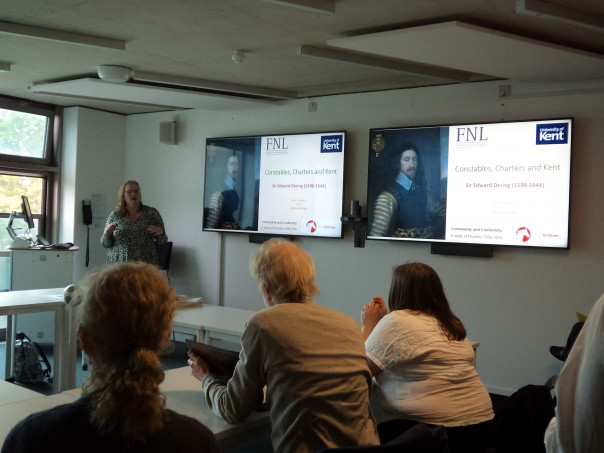
This was extremely interesting, and it was then great to hear about another aspect of Dering’s life from Kaye, and for her presentation we had very different Dering productions in the form of a book of accounts and the family Book of Remembrances to which Sir Edward contributed alongside those of other family members. Kaye also provided the audience with further biographical details and set Sir Edward and family within the context of their seat of Surrenden at Pluckley. Thus, amongst other details we learnt about the ‘battle’ between the Derings and their local rivals (the consequence of earlier running out of male heirs and the inheritance split between daughters), as well as more respecting Sir Edward’s creative abilities to push back his family’s noble ancestry, the production of coats of arms and the adding of them to memorial brasses being but some of his endeavours.
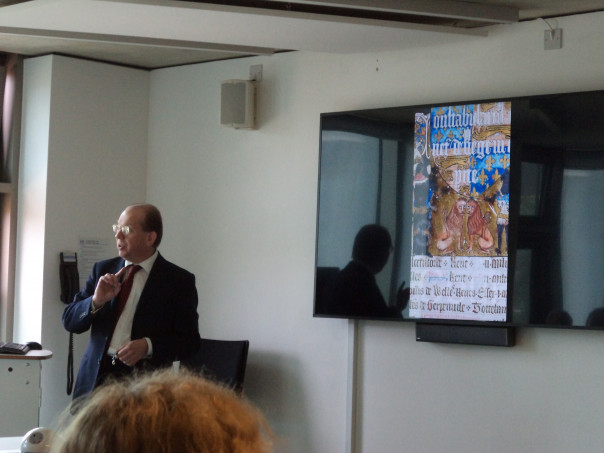
Following on from this excellent session, we had a break to examine the interesting books and documents that Karen and her team had provided for us to view and then reconvened for the final session as a double header of Drs Ryan Perry and David Rundle, which centred on palaeographical and codicological aspects of the Dover Castle Custumal and was an intriguing discussion between these two experts from MEMS at Kent. Moreover, it developed into a discussion about the role of antiquarians and their activities in the later 16th and 17th centuries, and how they saw themselves as guardians of such manuscripts, as well as improvers through their interventions – the addition of texts and images and matters such as binding or rebinding.
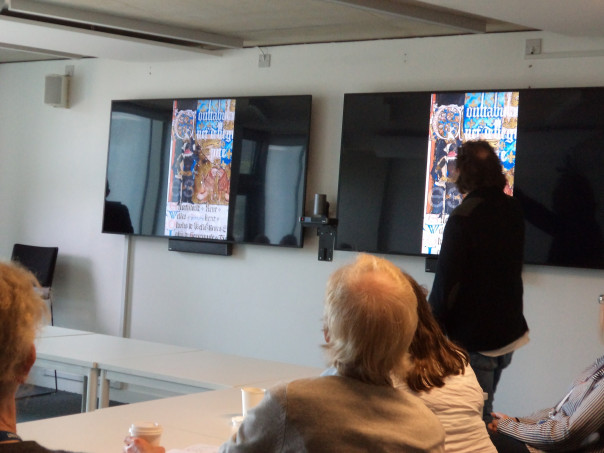
Again, this was another great session and the conference concluded at Canterbury Cathedral Archives where Cressida Williams and her team had set out an interesting range of manuscripts, maps and books for us to explore. All agreed that this had been an extremely worthwhile enterprise and the idea is to explore the possibility of this manuscript and other materials from the Dering archive becoming the focus for postgraduate projects in conjunction with the Kent Archives.
Keeping with Dover and a royal institution, Martin Crowther of the NLHF-funded Maison Dieu project had invited me to give a talk on St Mary’s hospital (its other name). Consequently, last night (Wednesday) over 50 people came to the Community Cinema at Dover Museum to find out about the history of the hospital through an examination of the inter-relationships between those inside and outside its gates. I did this by looking at three ‘snapshots’: the early 13th century, the mid/late 14th century and the late 15th/early 16th century because this offers insights into the place of the hospital locally, regionally and nationally, as well ideas about Dover’s medieval society more broadly.
Just by way of an example to illustrate this approach, I looked at the way the crown had appropriated the charitable gift of hospitality in the form of royal corrodians – generally aged royal retainers who were to be given board and lodging for the remainder of their lives at the hospital’s expense consequent on Henry III’s donations to the place. The first known corrodian is Henry le Blessid, who resided there until his death in 1315, and thereafter there was an almost continuous stream of corrodians filling the dead man’s shoes. Interestingly, James le Palmere of London, a clerk, was especially favoured regarding the rations he received, an annual gift of a new gown, a chamber apparently for his sole use and the privilege of sitting at the master’s table at breakfast and at dinner each day, including in the master’s own chamber.
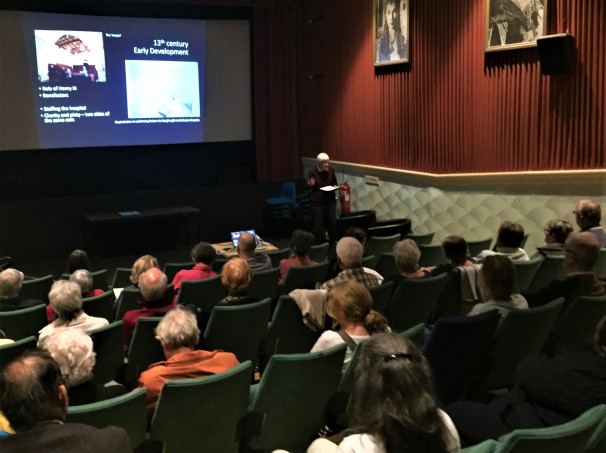
From the questions afterwards it appeared that the audience had enjoyed the presentation and I’ll be writing a summary as well for the Maison Dieu’s own blog at Martin’s invitation. Consequently, this brings me to the final section for this week which I’m going to offer a very rapid round-up of what several members of the Kent History Postgraduates are doing currently. So many apologies but next month we will be having first Maureen Mcleod’s presentation and then in our second meeting another catch up where I’ll provide a fuller report. Among those who are writing chapters are Jane, Maureen, and Tracey, while Kaye has just completed one which she has submitted to her supervisor, Grace is working on her methodology section and Janet is editing her final version which will be submitted at the end of next month.
 Centre for Kent History and Heritage
Centre for Kent History and Heritage Sheila Sweetinburgh
Sheila Sweetinburgh 1264
1264


Good Morning. For those of us who have moved away from Canterbury,will you still be doing any zoom meetings . Please CAROL
FCAT, with the help of Archaeology, may try hybrid meetings, but CCCU as a general rule uses Teams not zoom